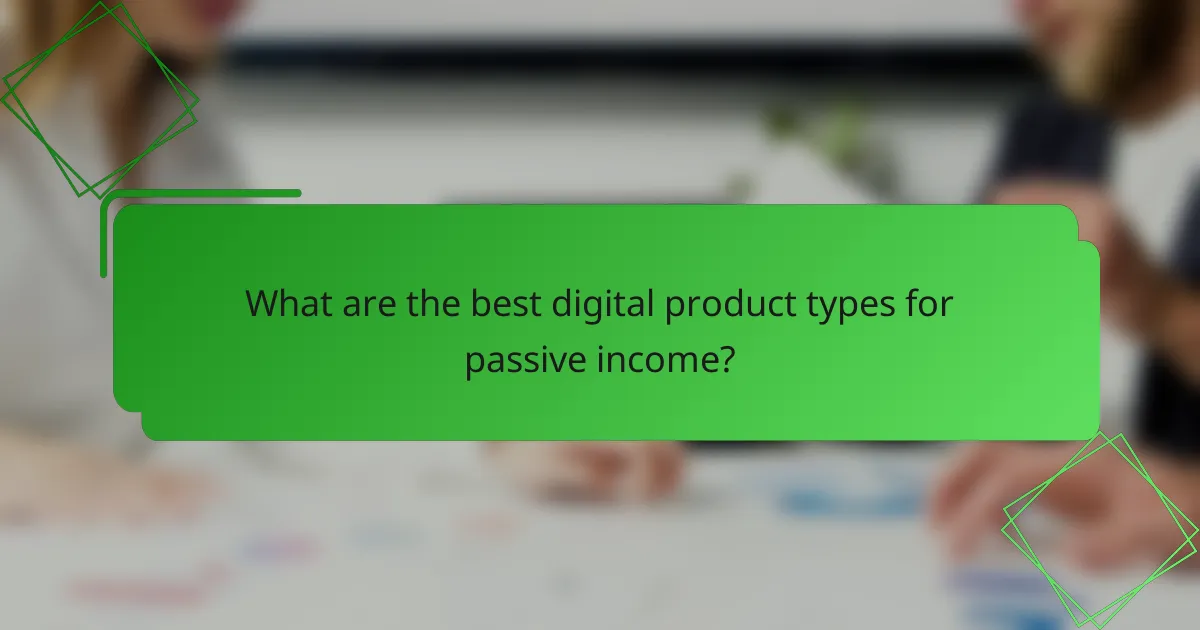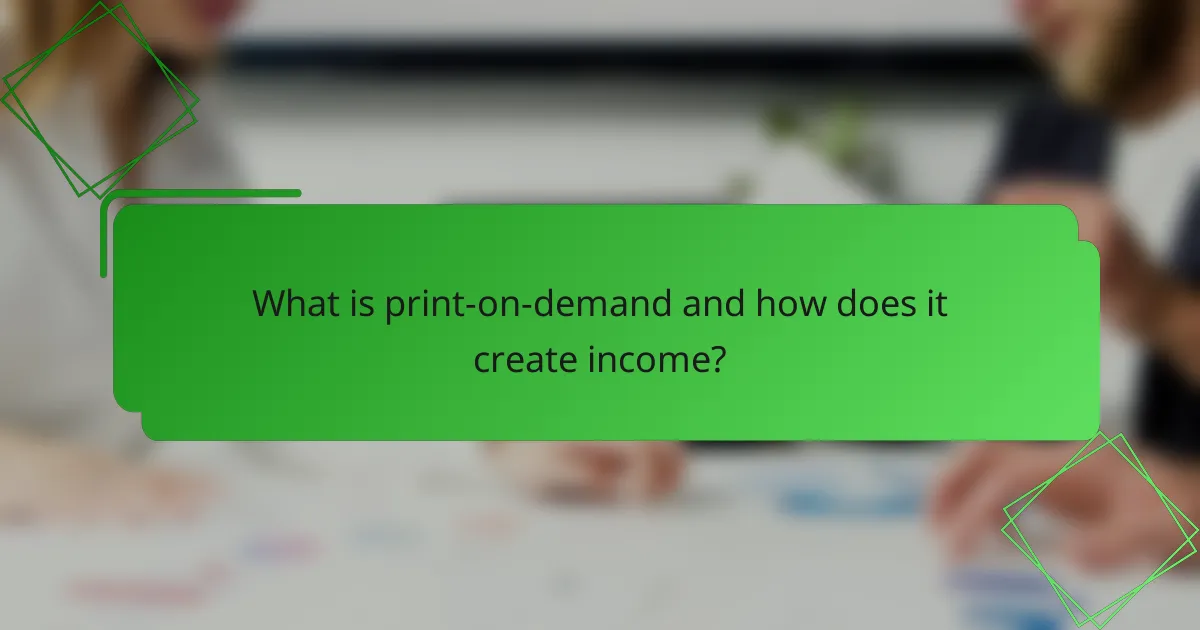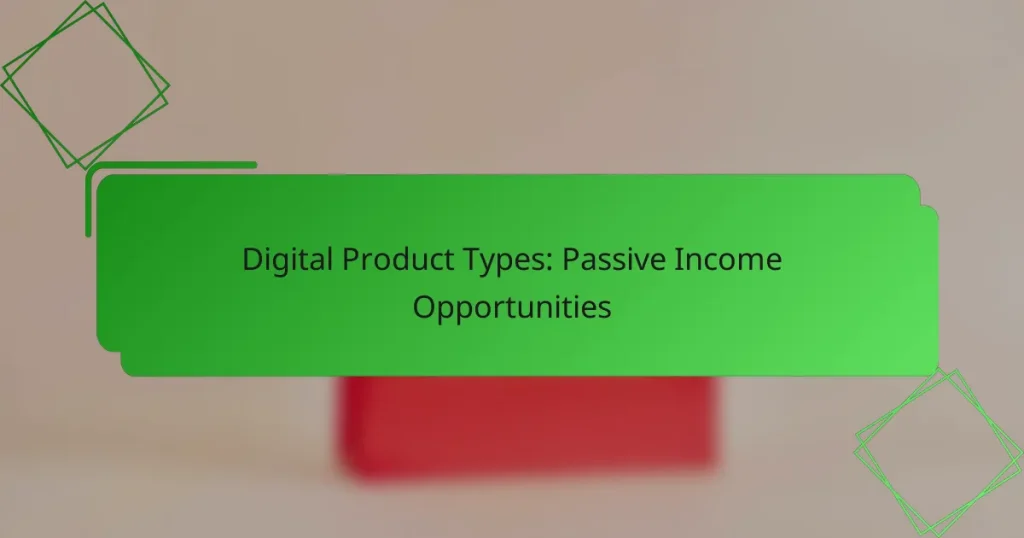Digital products offer a variety of passive income opportunities that can be highly lucrative with minimal ongoing effort. Options such as online courses, e-books, stock photography, print-on-demand merchandise, and subscription services allow creators to generate revenue repeatedly after the initial setup. By leveraging these digital assets, individuals can build a sustainable income stream while reaching a global audience.

What are the best digital product types for passive income?
The best digital product types for passive income include online courses, e-books, stock photography, print-on-demand merchandise, and subscription services. Each of these options allows creators to generate revenue with minimal ongoing effort after the initial setup.
Online courses
Online courses are structured educational programs that can be sold to learners worldwide. They typically include video lectures, quizzes, and downloadable resources, allowing for a comprehensive learning experience.
To create a successful online course, choose a niche you are knowledgeable about, outline your content, and select a platform like Udemy or Teachable for hosting. Pricing can vary widely, often ranging from $20 to several hundred dollars, depending on the depth and value of the course.
E-books
E-books are digital books that can be sold directly to consumers or through platforms like Amazon Kindle. They offer a flexible format for sharing knowledge, stories, or specialized information.
When writing an e-book, focus on a specific topic that addresses a common problem or interest. Consider pricing your e-book between $2.99 and $9.99 to attract buyers while ensuring a reasonable return. Use platforms that facilitate distribution and marketing to maximize reach.
Stock photography
Stock photography involves selling high-quality images for commercial use. Photographers can upload their work to stock sites like Shutterstock or Adobe Stock, earning royalties each time their images are downloaded.
To succeed in stock photography, focus on creating images that are in demand, such as lifestyle, business, or nature shots. Ensure your photos meet the technical requirements of the platform and consider pricing your images competitively to attract buyers.
Print-on-demand merchandise
Print-on-demand merchandise allows creators to design products like t-shirts, mugs, or posters without holding inventory. When a customer makes a purchase, the item is printed and shipped directly to them.
To get started, choose a niche and create unique designs using platforms like Printful or Redbubble. Set competitive prices while considering production costs, typically ranging from $10 to $30 per item. Promote your products through social media and online marketing to drive sales.
Subscription services
Subscription services provide ongoing access to content or products in exchange for a recurring fee. This model can apply to various offerings, including newsletters, software, or curated goods.
To establish a subscription service, identify a target audience and create valuable content or products that justify a monthly fee. Pricing can vary, but many services charge between $5 and $50 per month. Focus on delivering consistent value to retain subscribers and reduce churn.

How can online courses generate passive income?
Online courses can generate passive income by allowing creators to sell educational content repeatedly without significant ongoing effort. Once developed and launched, these courses can provide a steady revenue stream as students enroll over time.
Course platforms like Teachable
Platforms such as Teachable simplify the process of creating and selling online courses. They provide tools for course design, payment processing, and student management, enabling creators to focus on content rather than technical details.
When choosing a platform, consider factors like pricing, ease of use, and features. Teachable, for example, charges a monthly fee along with transaction fees, which can vary based on the plan you select. This can influence your overall earnings, so evaluate your expected sales volume against the costs.
Automated marketing funnels
Automated marketing funnels are essential for promoting online courses and converting leads into paying students. These funnels typically include a series of emails and landing pages designed to nurture potential customers until they are ready to purchase.
To create an effective funnel, start by offering a free resource related to your course, such as a webinar or eBook. This can attract interest and build your email list. Use follow-up emails to highlight course benefits, share testimonials, and create urgency with limited-time offers.

What are the advantages of selling e-books?
Selling e-books offers several advantages, including low overhead costs and the ability to reach a global audience. These factors make e-books an attractive option for generating passive income.
Low production costs
The production costs for e-books are significantly lower than for traditional print books. Authors can create, format, and publish their work without the need for physical materials or large printing runs.
Typically, expenses may include software for writing and design, which can range from free to a few hundred dollars. Additionally, self-publishing platforms often charge minimal fees, allowing authors to retain a larger share of their earnings.
Global distribution
E-books can be distributed worldwide with ease, reaching readers in various countries without the logistical challenges of shipping physical books. This global reach can significantly increase potential sales.
Platforms like Amazon Kindle, Apple Books, and Google Play Books enable authors to publish their e-books and make them available in multiple languages and regions. This accessibility allows for a broader audience and the possibility of higher sales volume.

How does stock photography work for passive income?
Stock photography allows photographers to earn passive income by licensing their images to individuals and businesses. Once uploaded to stock photography platforms, these images can generate revenue each time they are downloaded or purchased by users.
Platforms like Shutterstock
Platforms such as Shutterstock, Adobe Stock, and Getty Images serve as marketplaces for stock photography. Photographers can create accounts, upload their images, and set their pricing or allow the platform to manage it. These platforms typically take a commission from each sale, which can range from 15% to 50% depending on the platform and the contributor’s level.
To maximize earnings, photographers should focus on high-demand niches, such as business, lifestyle, or nature photography. Regularly updating portfolios with fresh content can also enhance visibility and sales potential.
Licensing models
Stock photography typically operates under two main licensing models: royalty-free and rights-managed. Royalty-free licenses allow buyers to use images without paying additional fees after the initial purchase, making it a popular choice for many users. In contrast, rights-managed licenses offer more control over how an image can be used, often at a higher price point.
Understanding these licensing models is crucial for photographers. Choosing the right model can impact pricing strategy and potential earnings. Photographers should consider their target audience and how they want their images to be used when selecting a licensing option.

What is print-on-demand and how does it create income?
Print-on-demand (POD) is a business model that allows creators to sell custom designs on various products without holding inventory. It generates income by printing items only after a customer places an order, minimizing upfront costs and risks.
Integration with Shopify
Integrating print-on-demand services with Shopify is straightforward, allowing sellers to set up an online store quickly. Popular POD platforms like Printful or Printify offer seamless integration, enabling automatic order fulfillment and tracking.
Once connected, you can easily upload your designs, select products, and customize your store’s appearance. This integration streamlines the process, allowing you to focus on marketing and customer engagement rather than logistics.
No inventory management
One of the key advantages of print-on-demand is the elimination of inventory management. Since products are printed only after orders are placed, you don’t need to invest in stock or worry about unsold items.
This model reduces overhead costs and simplifies operations, making it ideal for entrepreneurs who want to start a business with minimal financial risk. However, it’s essential to choose reliable POD providers to ensure quality and timely delivery to customers.

What are the key criteria for selecting a digital product?
When selecting a digital product, focus on market demand, target audience, and your own expertise. These criteria help ensure that your product not only meets consumer needs but also stands out in a competitive landscape.
Market demand analysis
Conducting a market demand analysis involves researching current trends and consumer preferences. Use tools like Google Trends or social media insights to gauge interest in specific digital products, such as e-books, online courses, or software applications.
Consider the competition as well. Identify existing products and assess their strengths and weaknesses. This can help you find gaps in the market where your digital product can thrive.
Target audience identification
Identifying your target audience is crucial for tailoring your digital product to meet their specific needs. Create buyer personas based on demographics, interests, and pain points to better understand who will benefit from your product.
Utilize surveys or feedback from potential customers to refine your understanding. This direct input can guide product features and marketing strategies, increasing the likelihood of success in your chosen market.

How can subscription services enhance revenue streams?
Subscription services can significantly boost revenue by providing a steady stream of recurring income. This model allows businesses to predict cash flow more accurately and build long-term customer relationships.
Recurring payments
Recurring payments are the backbone of subscription services, enabling businesses to charge customers on a regular basis, such as monthly or annually. This approach ensures a consistent revenue flow, which can be reinvested into the business for growth or improvement. Many companies offer tiered pricing plans to cater to different customer needs, often ranging from basic to premium options.
For example, a software company might charge $10 per month for basic access and $30 per month for premium features. This pricing strategy not only attracts a wider audience but also encourages users to upgrade as their needs evolve.
Customer retention strategies
Effective customer retention strategies are crucial for maximizing the benefits of subscription services. Retaining existing customers is often more cost-effective than acquiring new ones, making it essential to focus on delivering value and maintaining engagement. Regular communication, personalized offers, and loyalty rewards can enhance customer satisfaction and loyalty.
For instance, businesses can implement automated email campaigns to remind subscribers of upcoming renewals or offer discounts for long-term commitments. Additionally, soliciting feedback and making improvements based on customer input can foster a sense of community and belonging, further encouraging retention.


